Hardwood Floor Installations
At Tadas Wood Flooring we’re well known for specializing in hardwood floor refinishing in Naperville and the surrounding Dupage County. But we also offer hardwood floor installation services too.
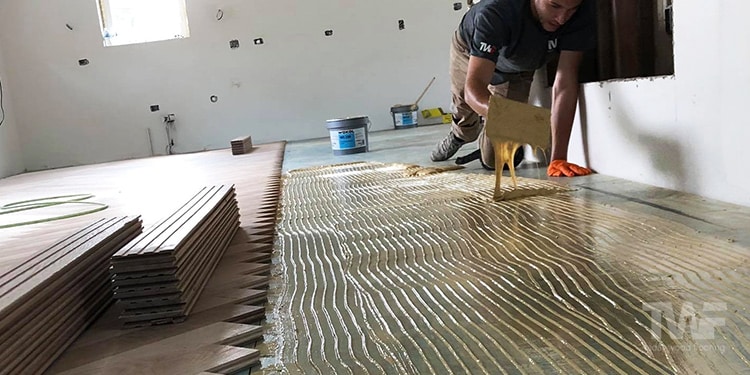
Usually when we are asked to install hardwood it’s to match existing hardwood floors in other rooms.
For example a client might have hardwood floors in the living room, hallways and dining room but have carpet in the bedrooms and wants wood floors in those rooms as well. Or, there may be wood floors in the living room and tile in the dining room, but they’ve opened the walls up and now need a seamless wood floor to tie it all together.
That’s a big part of the wood flooring installation services we offer.
It’s very satisfying to be able to blend together old wood floors with new sections then sand and refinish them to end up with a brand new seamless floor.
But… apart from matching existing floors, we also install brand new unfinished hardwood floors in homes.
Starting from scratch can be a lot of fun because the choices for new floors are pretty much limited only by your imagination. There are so many types of wood, sizes and colors to choose from and we can definitely help you with that process.
So How are Hardwood Floors Installed?
Below is a few of the main steps we go through when installing a new hardwood floor in a home:
The first step in installing floors is having it delivered and then waiting for it to acclimate. It’s important for the moisture content to be matched to the existing sub-floor so there are no moisture issues down the road, like cupping or excessive gaps. This can take a couple of days or much longer, depending on the moisture content difference between them…
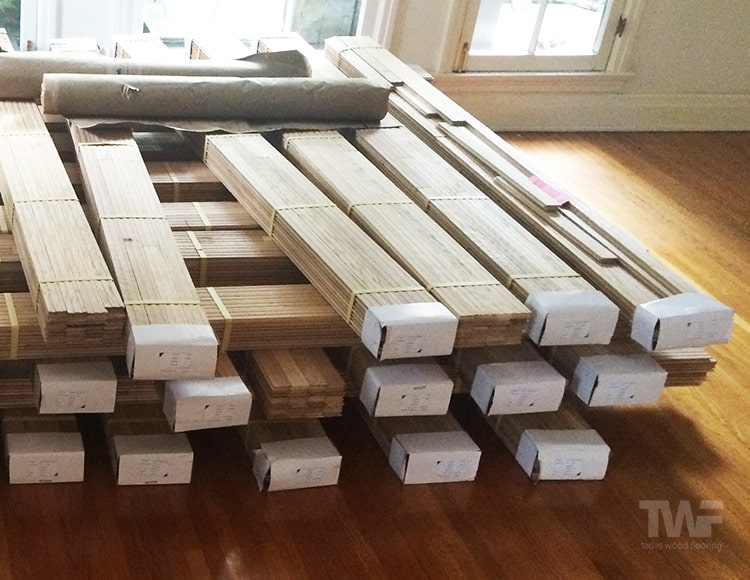
Once the floor is acclimated and ready to install, the existing floor has to be prepped. The old flooring – usually carpet, laminate, vinyl or tile – is removed and the sub-floor is cleaned up and inspected to make sure it’s OK to be used as an adequate base for the new hardwood.
It’s at this stage that any repairs to the joists or sub-floor needed are taken care of…
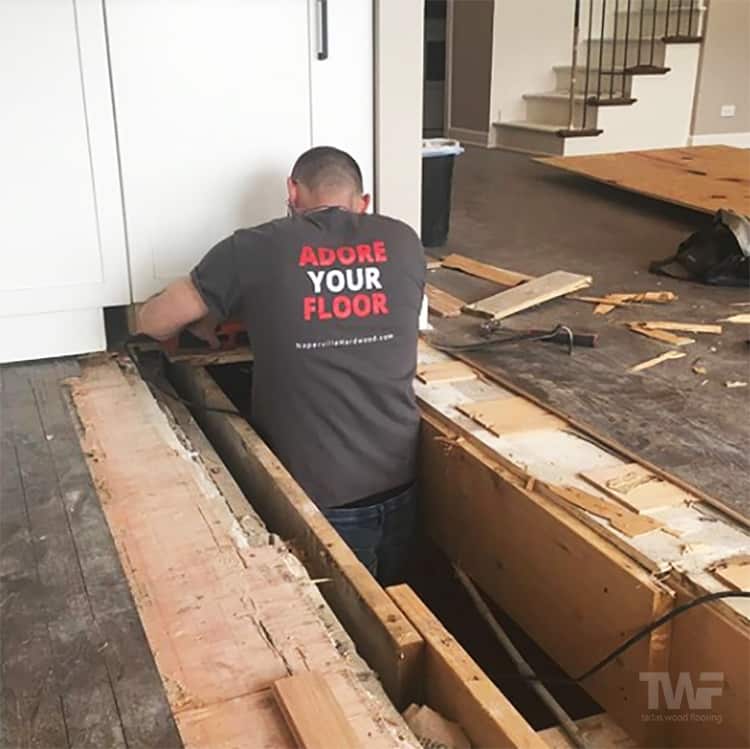
In the photo below, not only did the carpet need to be removed, the previous sub-floor needed to be taken up as well…
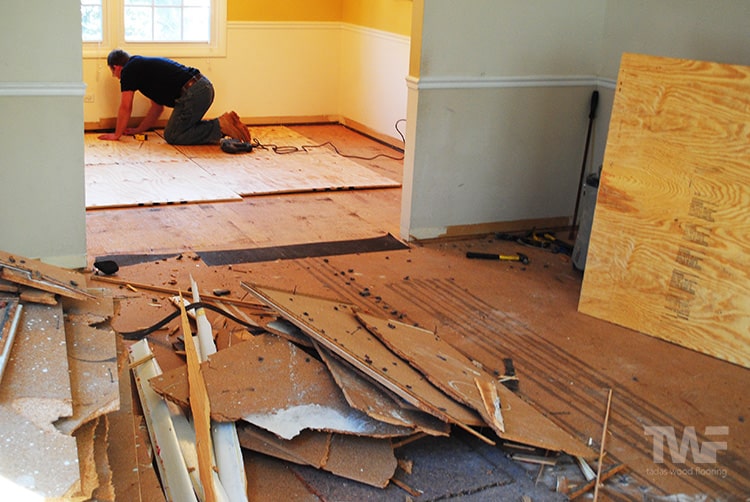
Making sure you have a suitable sub-floor is incredibly important in order to have a long lasting and professional installation. There has to be a solid base for the new hardwood to be attached to ensure a strong and stable install.
A good quality plywood is essential.
If your sub-floor is not up to par and the staples or nails don’t have proper grip, you’ll be dealing with problems like creaks and squeaks and loose boards down the road.
Dips, ridges, bumps and high spots all have to be leveled out during this stage as well. And while you will never have a perfectly level sub-floor, we need to make sure it’s as flat as possible.
The photo above shows the old particleboard sub-floor that had to be ripped up and removed because, while it was OK for a carpet install, hardwood flooring nails would never have held properly. After a few years the floor would have loosened and become a disaster.
As you can see, we had to install a new solid plywood sub-floor to ensure a professional job…
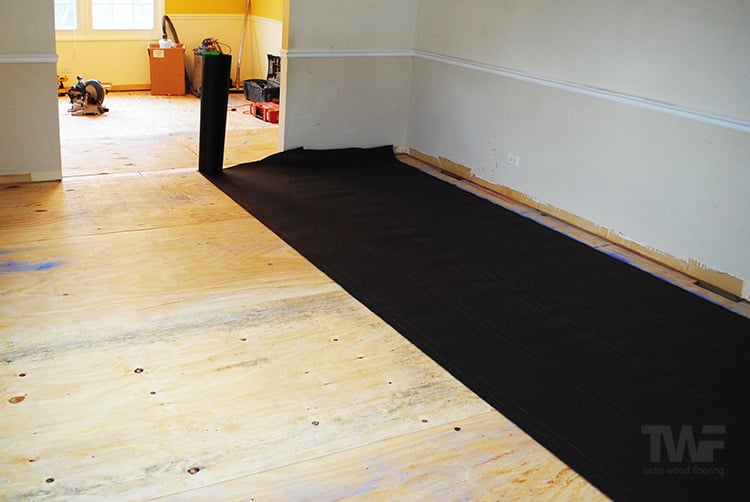
Now on to the 2 types of installations possible for your wood floors. Which one you choose will depend on a few different considerations we’ll go over below…
Nail Down Installations:
Nail down installations are the simpler, faster and cheaper of the two install options. As long as you have a good plywood sub-floor to nail to, you should have no issues.
After making sure the new sub-floor is solid, flat, free of squeaks and there are adequate expansion gaps, we roll out asphalt paper and start laying out the beginnings of the new floor.
During this stage many measurements are taken to make sure everything will line up and look great between all walls and doorways. A straight line is snapped and the first rows of wood are installed…
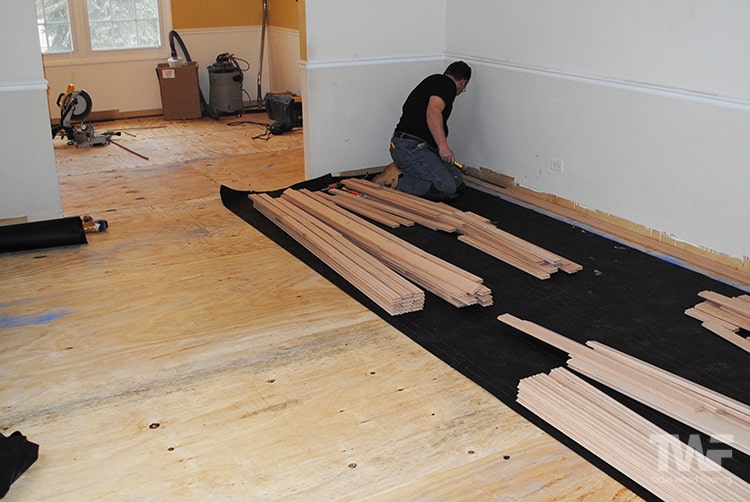
Once the first few rows are done things really start to speed up. We work in two’s, with one guy racking the floor (measuring and setting out the pieces)…
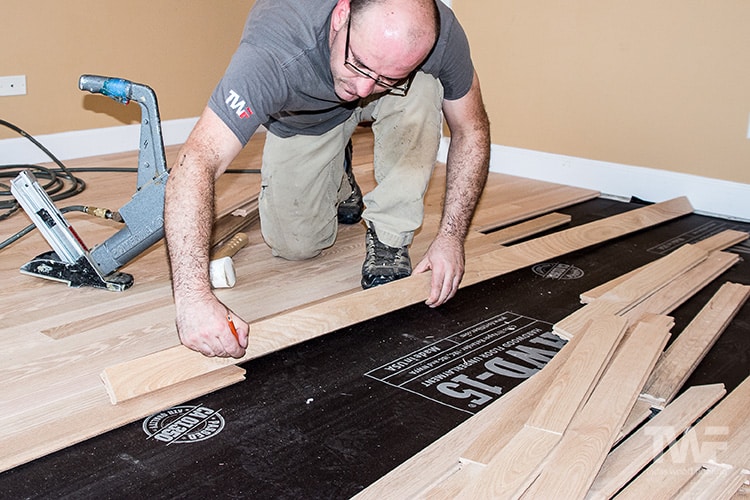
And another guy nailing or stapling them to the sub-floor…
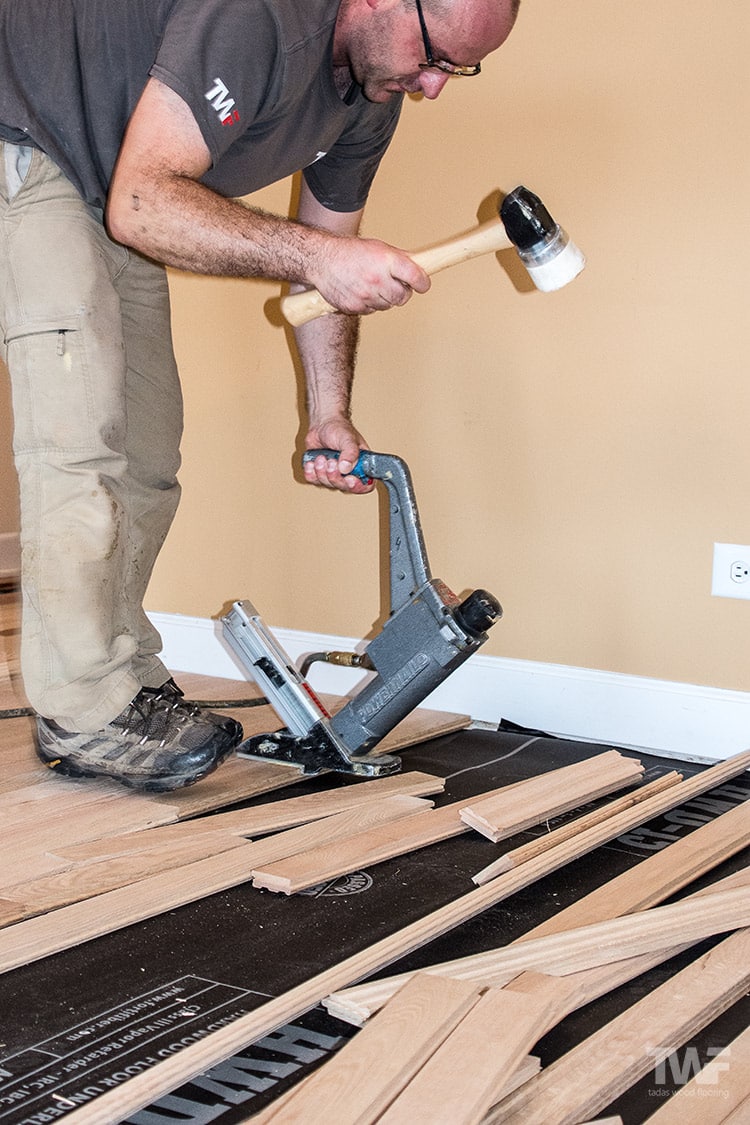
And below you can see the custom cuts needed for various areas, like this flush mount heating vent…
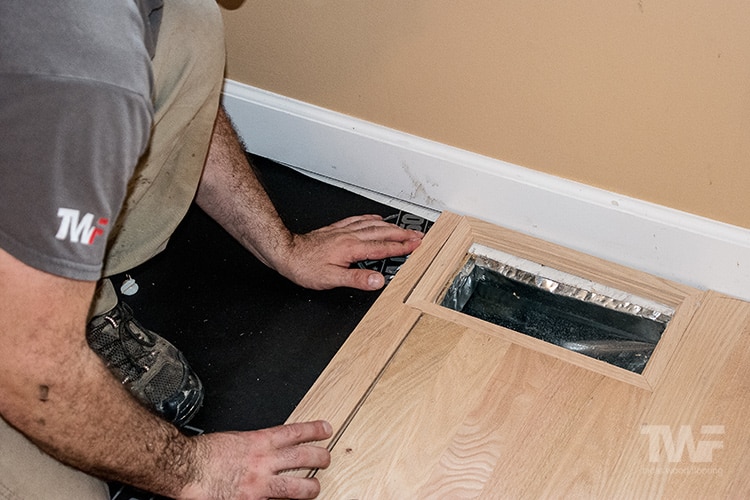
After lots of work, the finished install. It’s flat, tight and strong, all ready for the next stage… a professional sand and finish…
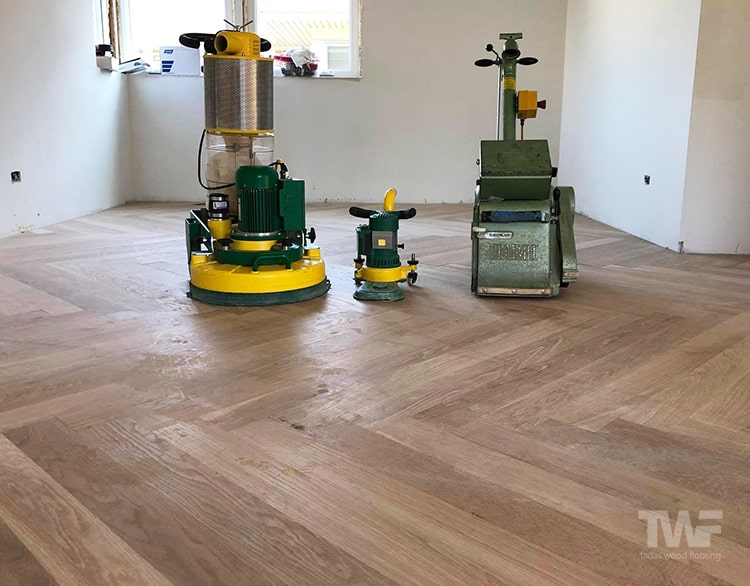
As you can see there’s a lot that goes into a quality install.
Glue Down or Glue-Assist Installation:
The other install option is using glue to secure the wood flooring to the sub-floor. This is more labor and product intensive, and therefore more expensive option.
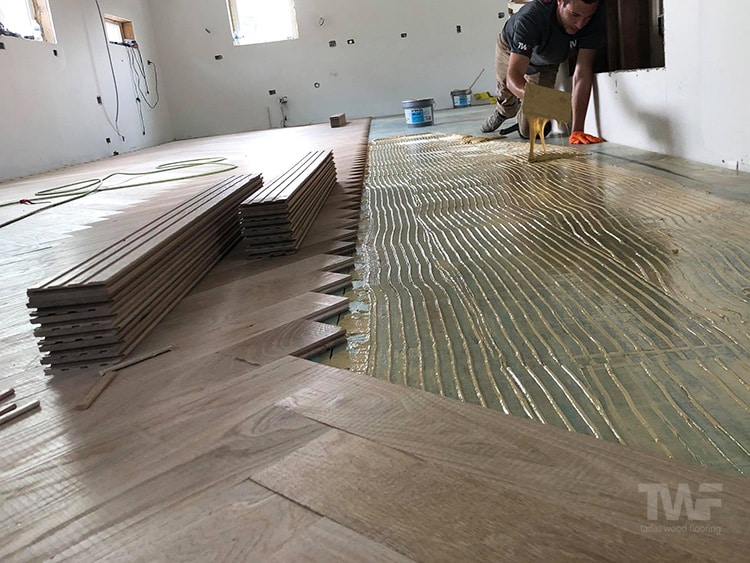
This option has numerous benefits over a nailed down floor in certain circumstances.
- It can be used to install a wood floor over concrete without first installing a plywood sub-floor. A sub-floor will raise the height of the floor and can be an issue in areas like kitchens where height is important for fitting refrigerators and dishwashers.
- If you are installing a wood floor below grade, like in a basement, then a glue down installation over a moisture barrier is recommended.
- If you have wide plank flooring, or want a herringbone or a chevron pattern, then you may need to have a glue assist installation. This is where we use nails as well as glue to secure the wood floor.
Below you can see a herringbone floor being glued to a plywood sub-floor, as well as being nailed…
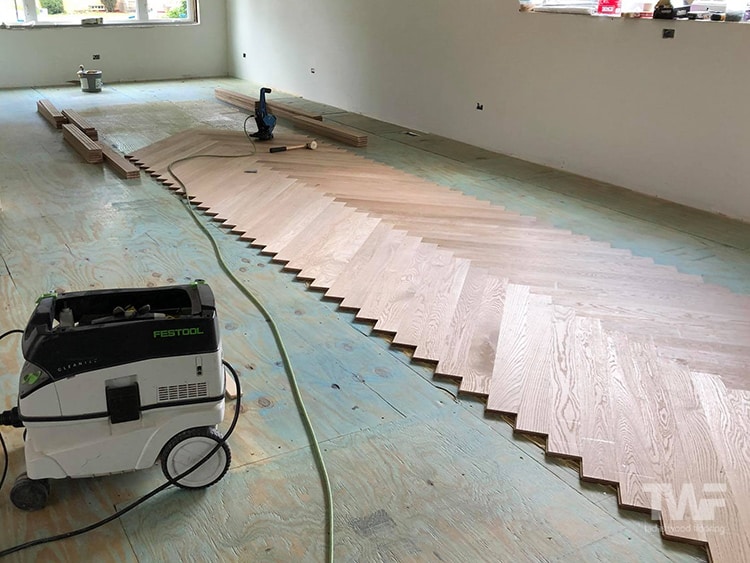
Another photo showing the glue application…
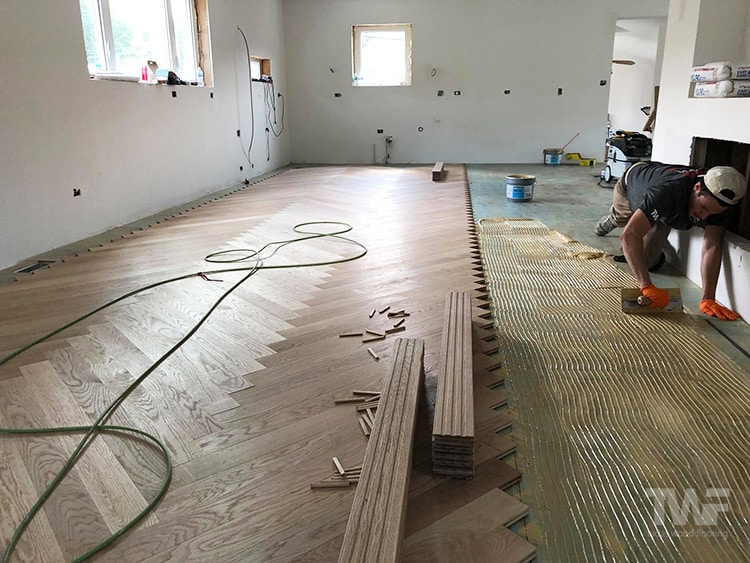
And here is the main field of the floor installed, ready for the border to be installed…
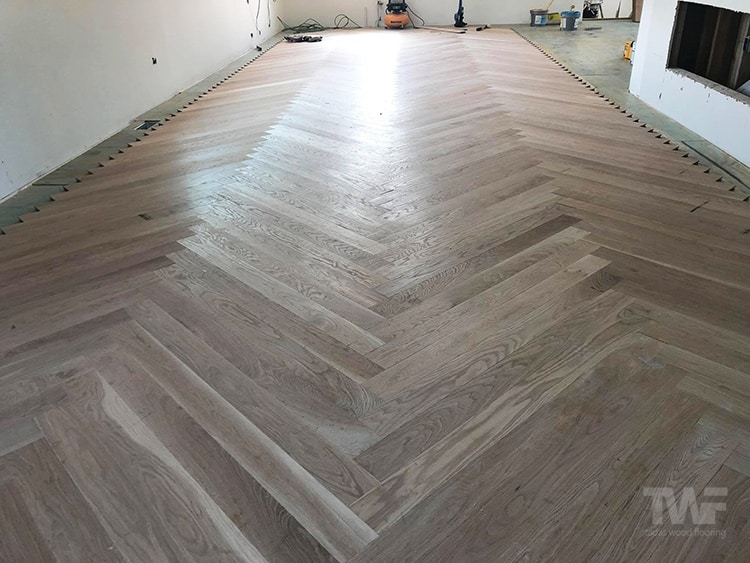
Unfortunately there are lots of documented failures in the hardwood flooring install world. When a hardwood floor fails it’s very, very expensive and time consuming to repair.
Most hardwood floor failures are caused by inadequate sub-floor preparation, lack of install experience, poor preparation, improper acclimatization, lack of moisture education and how it affects wood, cutting corners (easy to do on a sub-floor that no-one sees) and rushing the job.
We’re happy to say that we have years and years of experience with hardwood floor installations in Naperville and the Dupage County area without any incident. Mainly because we take our time, check all the boxes off as we proceed through the preparation and install stages and we don’t ever take any shortcuts.
So if you live in our Naperville service area and have a wood floor that needs to be extended into other rooms of your house, or you just want to finally get rid of that horrible dusty carpet and replace it with beautiful hardwood floors, then give us a call and we’ll set up a time to come over to your home and discuss what we can do for you.
Next post we’ll talk about the difference between prefinished and unfinished hardwood floors.
–
Updated Jan 2023

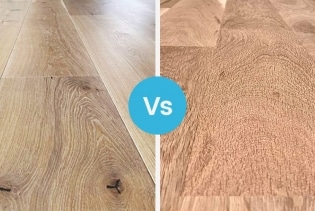

Maple vs. Oak vs. Walnut…vs. finish options?
In the process of researching all of the wood and finish options and came across your great site. Hoping you can provide a little bit more information as we’re not sure which is the best option. Our biggest concern with a wood floor is standing up the our dogs (3) high traffic. We thought we wanted to install Brazilian Walnut for the hardness, but we would like a more consistent color throughout. So my question is should we install a maple or oak and stain it (love the dark ebony stain you achieved in Deerfield) and then finish with a professional application of the 2 part water finish, or should we install the walnut and apply the professional 2 part water finish with the hopes it will darken with application and time?
Hi Ann,
Choosing from all the types of wood available can be daunting and confusing can’t it. When issues like having dogs come into it, it’s even more fun :)
What kind of dogs do you have? Little fluffy things or big clawed giant dogs…
As far as wood hardness you’re right about Ipe (Brazilian Walnut) being the toughest of the three. Maple is the next toughest followed by White Oak and then lastly Red Oak.
You can see the scores they get on the Janka hardness test here: http://en.wikipedia.org/wiki/Janka_hardness_test
Ipe is almost three times harder than Red Oak. It’s one tough floor. But… if you install it and hate the look of it, then no matter how well it holds up, you’ll never be happy with it. Hardwood floors make up such a large part of a homes interior style and they’re a big investment so you really need to be able to live with your choice.
Ipe will darken over time but it will never look like the Ebony stained floors we did in Deerfield that you like. Those staned floors have a very even and consistant appearance to them unlike Ipe which has lots of color and grain variation between boards. But they’re also nowhere near as hard as Ipe.
Maple doesn’t take stain as consistantly as oak and it’s not a huge amount harder than White Oak anyways so I would rule that out.
Basically it will come down to what you deem more important – looks or durability.
If you really love the looks of an even, dark stained floor go with White Oak and a high-end 2 component finish like Pallmann’s Pall X-98 that we use. Or, if you want one of the toughest floors available and can live with the looks of Ipe (many people would die to have these floors in their home) then that’s the way to go.
Hope you can make a good decision for you floors Ann. Let us know what you decide.
Tadas